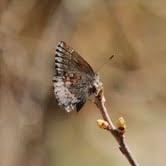
Juniper hairstreak, photo’d by Harvey Tomlinson, Lizard Tail Swamp Preserve, 4-24-11
Last year we found all seven NJ Callophrys before April ended, and we did it again this year.
This year’s sequence:
Henry’s elfin: 3/19/11 (Belleplain State Forest)
Eastern pine elfin: 4/9/11 (Belleplain State Forest)
Brown elfin: 4/11/11 (Glassboro WMA)
Frosted elfin: 4/12/11 (Lizard Tail Swamp)
Juniper hairstreak: 4/24/11 (Lizard Tail Swamp)
Hoary elfin: 4/24/11 (Warren Grove)
Hessel’s hairstreak; 4/24/11 (Parker Preserve)
As most observers know too well, all Callophrys but juniper (and rarely, apparently, Hessel’s) are single-brooded/univoltine species. They fly as adults for a couple of weeks in early spring to mate and lay their eggs and then do not fly again for another 11 months. We must see them now or wait ’till next year, in other words.
Here’s hoping you can get out into the field over the next couple of weeks to appreciate them.
For an extra challenge: can we find any of the three rarest members of the group outside their best-known locales?

Hessel’s hairstreak, photo’d by Stephen Mason, Franklin Parker Reserve, 4-24-11
1. How many different places can we find Hessel’s this year? Last year we found the species in only four places — Parker Preserve (Burlington Co.), Rt. 72 (Burlington Co.), Warren Grove (Burlington Co/Ocean Co.), and Old Robbins Trail (Cape May Co.).
2. A tougher challenge: Can any of us photo a frosted elfin outside of Cape May County — or how about anywhere away from Lizard Tail and Dennisville?
3. And finally, perhaps the toughest challenge here, can we find and photo a hoary elfin anywhere but in Warren Grove? Bearberry does grow outside Warren Grove, of course. Can we find a new colony of C. polios this year?
Finding either frosted or hoary away from their known colonies would be an exciting and very significant find!
Keep exploring and reporting!
jc
Hoary elfin, photo’d by Barbara Sendelbach, Warren Grove, 4-24-11

